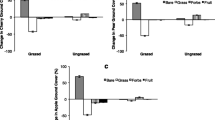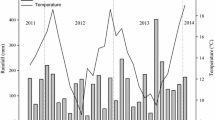Abstract
Organic tree fruit producers often rely on tillage in the tree row to control weeds and disrupt rodent pest habitat. This inexpensive practice can potentially damage the trees’ trunk and roots, thereby reducing yield and fruit quality. In contrast, mulching under the trees to suppress weeds often improves tree performance but at a high initial installation cost, whereas flame weeding and organic-compliant herbicides can control weeds without disturbing the soil. These three systems of weed management in the tree row were compared in commercial, certified organic apple and pear orchards in Washington State, USA, to determine the effectiveness for weed control and the impacts on tree performance, soil organic matter, and economic return of each system when taking into account both the cost of the weed control itself and its impact on fruit yield and quality. Mulching produced a large net economic benefit relative to tillage, more so in the apple orchard that had sandier soil than in the pear orchard on a loam soil. Flame weeding was similar to tillage in cost, whereas organic herbicides proved extremely expensive and relatively ineffective. Tillage did not lead to a decline in soil organic matter over three seasons, nor did mulching increase it. Overall, mulching led to better tree performance and economic returns but was not a successful stand-alone weed control practice over 3 years. A combination of flaming and tillage and/or mulch may offer the best overall results.

Similar content being viewed by others
References
Atucha A, Merwin IA, Brown MG (2011) Long-term effects of four groundcover management systems in an apple orchard. HortSci 46:1176–1183
Blanpied GD, Silsby KJ (1992) Predicting the harvest date window for apples. Information Bulletin 221, Cornell University Cooperative Extension, Ithaca, New York
Cambardella CA, Elliott ET (1992) Particulate soil organic-matter changes across a grassland cultivation sequence. Soil Sci Soc Amer J 56:777–783
Cockroft B, Wallbrink JC (1966) Root distribution of orchard trees. Austr J Agric Res 17:49–54
Forge TA, Hogue E, Neilsen G, Neilsen D (2003) Effects of organic mulches on soil microfauna in the root zone of apple: implications for nutrient fluxes and functional diversity of the soil food web. Appl Soil Ecol 22:39–54
Granatstein D, Mullinix K (2008) Mulching options for Northwest organic and conventional orchards. HortSci 43:45–50
Granatstein D, Sánchez E (2009) Research knowledge and needs for orchard floor management in organic tree fruit systems. Intl J Fruit Sci 9:257–281
Granatstein D, Wiman M, Kirby E, Mullinix K (2010) Sustainability trade-offs in organic orchard floor management. Acta Hort 873:115–121
Granatstein D, Kirby E, Willer H (2013) Global area and trends of organic fruit production. Acta Hort 1001:383–394
Kirby E, Granatstein D (2012) Status of organic tree fruit in Washington State. Washington State University Extension EM046E, Pullman, WA, 32 pp
Marriott EE, Wander MM (2006) Total and labile soil organic matter in organic and conventional farming systems. Soil Sci Soc Amer J 70:950–959
Merwin IA (2003) Orchard-floor management systems. In: Ferree DC, Warrington IJ (eds) Apples: botany, production, and uses. CABI, Cambridge, pp 303–318
Merwin IA, Stiles WC (1994) Orchard groundcover management impacts on apple tree growth and yield, and nutrient availability and uptake. J Amer Soc Hort Sci 119:209–215
Neilsen GH, Hogue EJ, Forge T, Neilsen D (2003) Mulches and biosolids affect vigor, yield and leaf nutrition of fertigated high density apple. HortSci 38:41–45
Pitts T, Craver D, Granatstein D, Stephens N (2010) Survey of organic growers toolbox: information gaps and research needs. Wash. St. Hort Assoc. Annual Meeting, Yakima, WA. http://csanr.wsu.edu/publications/presentations/Toolbox_WSHA2010.pdf. Accessed 9/13/13
Singleton VL, Orthofer R, Lamuela-Raventós RM (1999) Analysis of total phenols and other oxidation substrates and antioxidants by means of Folin-Ciocalteu reagent. Methods Enzymol 299:152–178
Stiles WC, Reid WS (1991) Orchard nutrition management. Information Bulletin 219, Cornell Cooperative Extension, Cornell University, Ithaca, NY, 23 pp
USDA (2001) National Organic Program. Sec. 205.203(a). e-CFR, USGPO, Washington, DC. http://www.ecfr.gov/cgi-bin/text-idx?c=ecfr&SID=5f0bd6d4250b77ba2115e700eaf82914&rgn=div8&view=text&node=7:3.1.1.9.32.3.354.4&idno=7. Accessed 9/13/13
Wiman MR, Kirby EM, Granatstein DM, Sullivan TP (2009) Cover crops influence meadow vole presence in organic orchards. HortTech 19:558–562
Wooldridge J, Harris RE (1989) Effect of ground covers on the performance of young apple trees and on certain topsoil characteristics. Deciduous Fruit Grower 39:427–430
Yao S, Merwin IA, Bird GW, Abawi GS, Thies JE (2005) Orchard floor management practices that maintain vegetative or biomass groundcover stimulate soil microbial activity and alter soil microbial community composition. Plant Soil 271:377–389
Zhao C-Z, Lu L, Peng C-Z, Chen B-H (2002) Effect of straw mulching on leaf physiological properties, size and growth curves of pear fruit in an arid desert area. Acta Hort 587:605–610
Acknowledgments
Funding for the study came from a USDA Specialty Crop Block Grant through the Washington State Department of Agriculture. We gratefully acknowledge the generous support of the Foreman Fruit and Land Co., Wenatchee, WA, for the use of their orchards to conduct these trials. We also acknowledge the valuable assistance of Cindy Kahn, Rachel Miller, Jackie Pitts, Awais Sial, and Luke Gustafson for their contributions to this study.
Author information
Authors and Affiliations
Corresponding author
Electronic supplementary material
Below is the link to the electronic supplementary material.
ESM 1
(DOCX 18 kb)
Rights and permissions
About this article
Cite this article
Granatstein, D., Andrews, P. & Groff, A. Productivity, economics, and fruit and soil quality of weed management systems in commercial organic orchards in Washington State, USA. Org. Agr. 4, 197–207 (2014). https://doi.org/10.1007/s13165-014-0068-0
Received:
Accepted:
Published:
Issue Date:
DOI: https://doi.org/10.1007/s13165-014-0068-0




